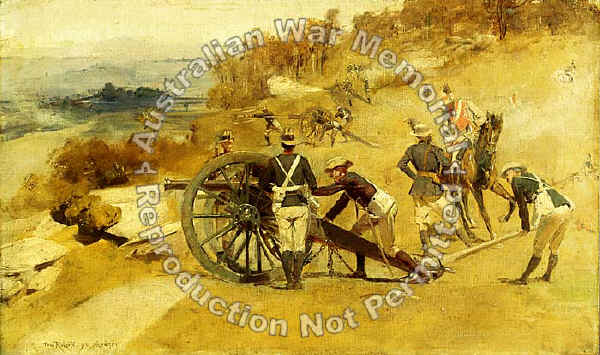|
The first Battle
Honour, or Honorary Distinction as it was correctly called, was awarded
in the British Army to the 18th Royal Irish Regiment by King William III
for its service at the siege of Namur in 1695. Thereafter the custom of
granting Battle Honours became more common.
All the regiments
which took part in the defence of Gibraltar (during the Great Siege of
1779-83) were allowed to bear the title "GIBRALTAR". This
included a number of batteries from the Royal Artillery. The Gunners
were also awarded the Battle Honour WATERLOO.
 |
| Tom Roberts established 'Curlew
camp" at Sirius Cove in Mosman by the end of the 1890s. While
camped there, concentrating on painting outdoors, Roberts was
commissioned to paint three works depicting the New South Wales
military forces, commanded by his friend, Major
General Edward Thomas Hutton, from 1893 - 1896. 'A' Battery
was formed in 1871 and later served in the Boer War. This work is
shows Artillery Battery manoeuvres at Campbelltown. |
In 1833, the Gunners
were granted two mottos, "UBIQUE" and "QUO FAS ET GLORIA
DUCUNT". It was stated that "UBIQUE" (Everywhere) was
also to be granted as a Battle Honour and was to substitute for
"all other terms of distinction for the whole Regiment". This
was the end of all other Battle Honours in the Royal Artillery.
A committee was
assembled in 1882, under Major General Sir Archibald Allison, to review
all the past history of the British Army and to regularise the holding
and the granting of Battle Honours, less the Royal Artillery who had
already been given the single Battle Honour UBIQUE.
The Honour is unique
to the Gunners. It simply means that wherever there is a battle the
Gunners are there, serving and supporting.
The Royal Regiment
of Australian Artillery was granted the Battle Honour, by His Majesty
King George VI, in January 1950 (it is not a Battle Honour for the
engineers). This included 6 Field Regiment Royal Australian Artillery
CMF who were granted approval and from then on wore a replica badge to
that of the famous parent corps, the Royal Artillery, and bears the same
two mottos - "UBIQUE" (Everywhere) which takes the place of
individual battle honours of an infantry regiment, and "QUO FAS ET
GLORIA DUCUNT". Unlike the infantry regiments of the line, the
Artillery has no regimental colours - its colours are the guns
themselves. Nor does the Artillery have battle honours - its battle
honour is the one word EVERYWHERE.
Battle honours are
not to be confused with "Honour Titles" which are borne by a
number of batteries in the Royal Artillery - an example is 171 (The
Broken Wheel) Battery RA.
There is a provision
made in the RAA Standing Orders for batteries to be granted Honour
Titles. The main rule applying for the granting of these titles is
"Place names should be limited to occasions of historic interest,
and even then be awarded only in outstanding cases where the
susceptibilities of other batteries are not likely to be hurt".
MOTTOES OF THE
REGIMENT
The Royal Regiment
of Australian Artillery was granted the two mottos of The Royal Regiment
of Artillery in 1950 by His Majesty King George VI: "UBIQUE"
(Everywhere) and "QUO FAS ET GLORIA DUCUNT" (Where Right and
Glory Lead).
The original motto
of the NSW Artillery was "SEMPER FIDELIS" (Always Faithful).
There is a line of thought that the motto in fact was "SEMPER
PARATUS" (Always Ready) but this appears to be incorrect, even
though 'A' Field Battery has adopted the latter.
After Federation the
motto was changed to "CONSENSU STABILES". There seems to be
three opinions as to the translation: Strong in Agreement, Firm and
Ready and, the most accepted, Firm and Steadfast.
The Gunner motto
used by Tasmanian Garrison Artillery was "PRO ARIS ET FOCIS"
(For Fields and Hearths).
THE ORIGIN OF THE
WHITE LANYARD
The lanyard had a
genuine purpose in war. It was originally a piece of cord, approximately
a metre in length, used to secure a jack-knife which was issued to both
the artillery and the cavalry. The knife had a number of uses; the blade
was for cutting loose horses which became entangled in the head and heel
ropes of the picket lines, and the spike of the knife was used as a hoof
pick, for the removal of stones from horses hooves. A fuse key was also
attached to the lanyard.
Hanging loose, the
lanyard soon became dirty and for the day-to-day barrack routine it
looked out of place on an otherwise smart uniform; so for peace time
purposes the lanyard was plaited, and whitened with Blanco, to match
both the white bandolier and the white waist belt worn by the gunners of
the day. The lanyard was worn on the left shoulder with the end
containing both the knife and fuse key tucked into the left breast
pocket.
In 1920 the lanyard
was moved to the right shoulder, simply because of the difficult problem
of trying to remove the knife from the pocket underneath the bandolier.
By now the bandolier and belt, worn with battle dress, had long ceased
to be white, whilst the lanyard remained so.
The knife was
removed in 1933 and the lanyard then became a straight cord, worn purely
as an ornamental item of dress.
In 1955 it was, for
a short time, reintroduced in the plaited style, but it quickly went
back to the straight lanyard currently worn today.
There is simply no
truth either to any other popular story regarding the Artillery's white
lanyard.
|